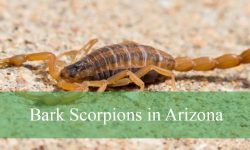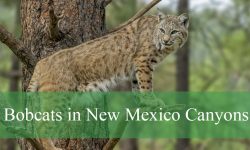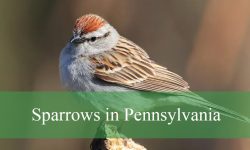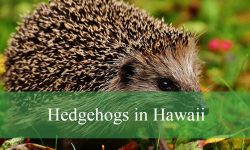California’s mountain regions host a rich variety of bird species, from dense pine forests to open alpine meadows. These environments provide essential habitats for many fascinating and unique birds. This guide showcases 20 notable Mountain Birds of California, featuring pictures and identification tips to help you spot them in their natural surroundings.
Hiking through the Sierra Nevada, exploring the coastal ranges, or wandering forested valleys, you’ll encounter birds that bring color and life to these landscapes. Learning about their behaviors and traits will deepen your connection to California’s mountainous ecosystems. The list includes vibrant songbirds, powerful raptors, and specialized species adapted to high elevations.
Discovering the 20 notable Mountain Birds of California will enhance your birdwatching adventures and broaden your understanding of these species’ important roles. This guide is designed to be your helpful companion for identifying and appreciating the diverse avian life thriving across California’s mountain habitats.
Common Mountain Birds of California
Steller’s Jay (Cyanocitta stelleri)
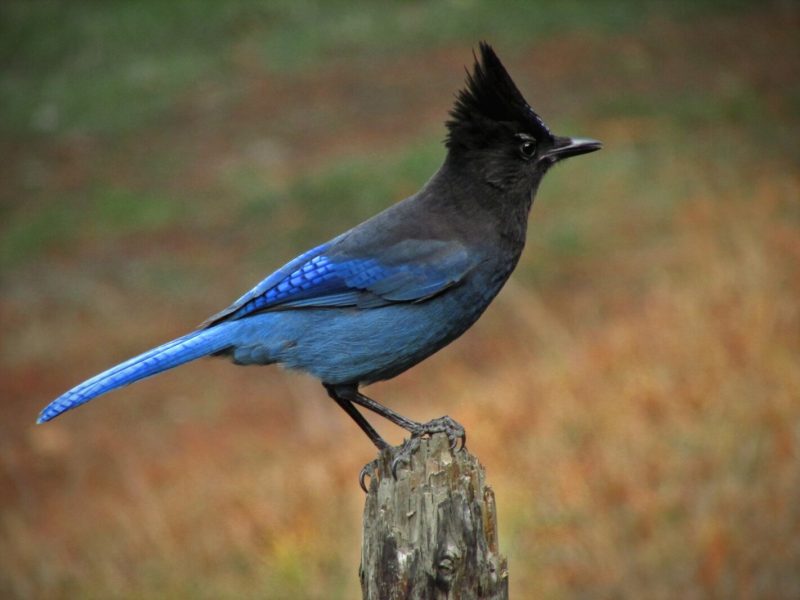
The Steller’s Jay is a striking bird with bold blue and black plumage, measuring about 30 cm in length. It features a distinctive crest on its head that adds to its unique appearance. Known for its loud and varied calls, this bird is very vocal and uses its sounds for communication and alerting others to danger.
This bird can be easily identified by its vibrant coloration and curious, active behavior. It typically inhabits pine and mixed conifer forests in mountainous regions, often seen hopping between branches or on the forest floor searching for food. Its diet includes seeds, nuts, insects, and occasionally small birds or eggs when opportunities arise.
In California, Steller’s Jays are common throughout the mountain ranges such as the Sierra Nevada and the coastal redwood forests. They thrive in environments with dense pine woodlands, adapting well to both natural forests and areas near human activity like campsites. Their inquisitive nature often leads them to approach people, especially where food is available.
Mountain Chickadee (Poecile gambeli)
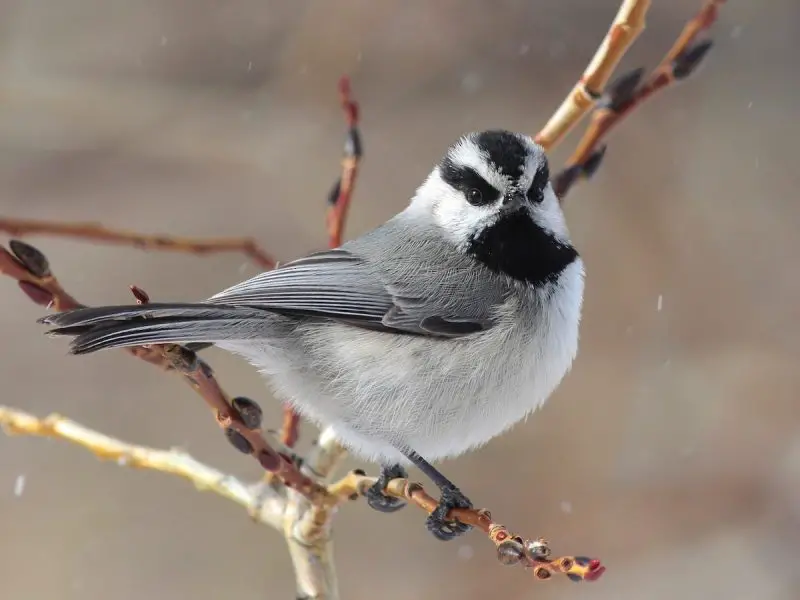
The Mountain Chickadee is a small songbird measuring about 12 to 15 cm in length, easily recognized by its sharp black-and-white head pattern. It has a black cap and bib, with white cheeks that contrast strikingly against the darker feathers. Its soft, clear calls are often heard before the bird is seen in the dense forest canopy.
This species is highly agile, flitting among pine and fir branches while searching for insects, spiders, and seeds. It uses its strong, short bill to pick insects from bark crevices and to crack open seeds. The Mountain Chickadee is known for its curious and social behavior, often forming small flocks in the non-breeding season.
Within California, Mountain Chickadees inhabit high-elevation coniferous forests in the Sierra Nevada and other mountain ranges. They prefer cooler environments with dense pine and fir trees where they find abundant food and nesting sites. These birds are an integral part of the mountain forest ecosystem and are active year-round.
Clark’s Nutcracker (Nucifraga columbiana)
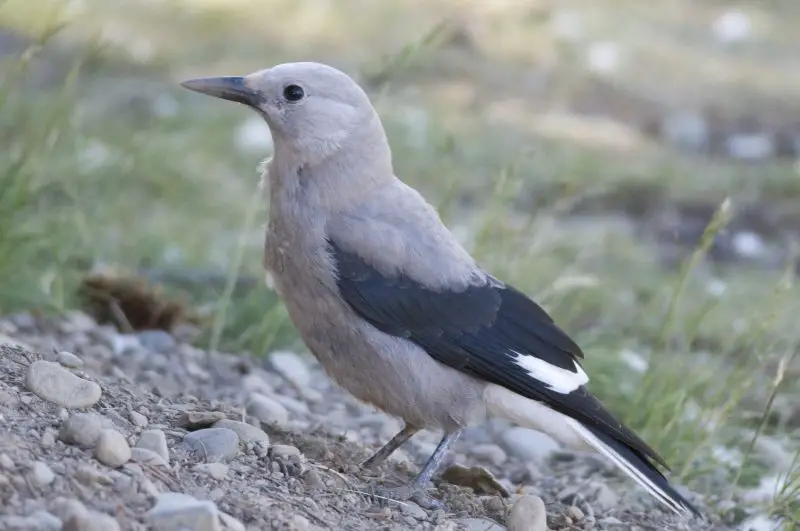
Clark’s Nutcracker is a pale gray bird approximately 30 cm long with contrasting black wings and tail. It has a strong, pointed bill perfectly adapted for extracting and carrying pine seeds. This bird is famous for its behavior of caching thousands of seeds during the late summer and fall to survive the harsh winter months.
It plays a crucial ecological role by dispersing seeds of high-elevation pine trees such as the whitebark pine, helping maintain forest regeneration. Clark’s Nutcrackers are often seen in open pine forests and rocky mountain slopes, where they use their sharp eyesight to locate buried seeds even under snow.
In California, Clark’s Nutcracker inhabits the mountainous areas including the Sierra Nevada and southern Cascades. They favor subalpine forests at elevations typically between 1,800 and 3,500 meters. Their specialized feeding and caching behavior make them vital to the survival of several pine species in these harsh environments.
Northern Goshawk (Accipiter gentilis)
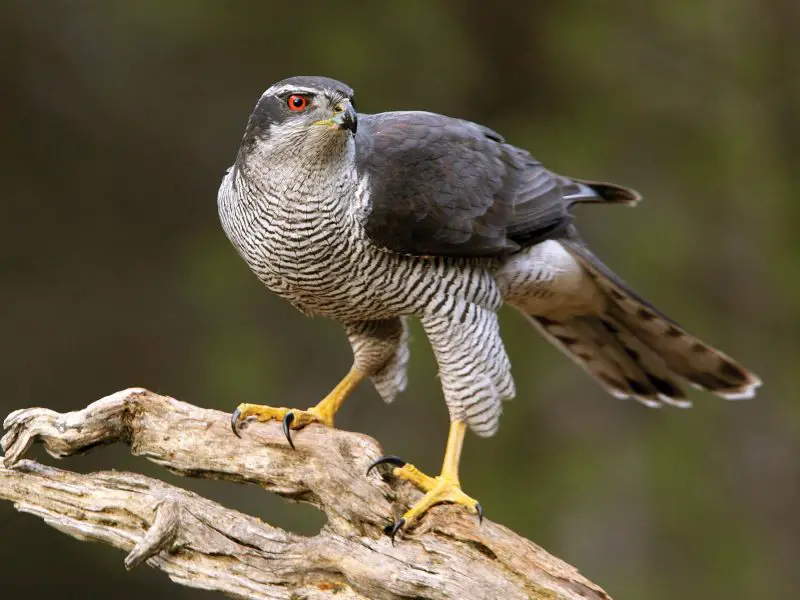
The Northern Goshawk is a powerful and agile hawk, measuring around 55 to 65 cm in length with a wingspan of up to 1.2 meters. It has slate-gray upperparts, pale underparts with fine barring, and striking red or orange eyes. This bird is an expert hunter, relying on speed and surprise to capture birds and small mammals in dense forest habitats.
Goshawks are known for their fierce and territorial behavior, often flying swiftly through thick woods and narrow canyons as they pursue prey. Their diet includes squirrels, rabbits, woodpeckers, and other medium-sized animals. Despite being relatively rare, spotting a Northern Goshawk soaring or darting through mountain forests is a remarkable sight.
In California, the Northern Goshawk is primarily found in the mountainous coniferous forests of the Sierra Nevada and northern coastal ranges. They prefer mature forests with dense canopy cover that provides stealthy hunting grounds. Conservation efforts are important as their populations are sensitive to habitat loss.
American Dipper (Cinclus mexicanus)
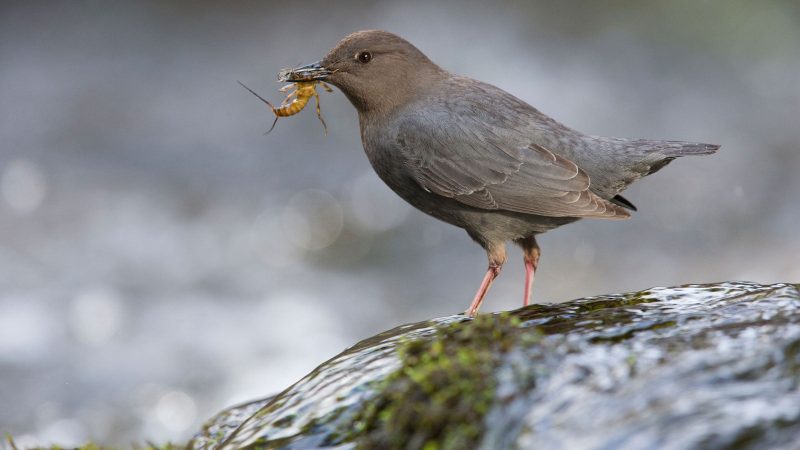
The American Dipper is a small, stout bird about 18 cm long, notable for its slate-gray plumage and unique behavior of diving underwater to forage. It inhabits fast-moving mountain streams and rivers, where it searches for aquatic insects, larvae, and small fish. Its strong legs and sharp claws help it cling to rocks in turbulent waters.
Unlike most songbirds, the American Dipper can swim and walk underwater using its wings for propulsion. It is often seen bobbing up and down on rocks near streams or diving beneath the surface to hunt. This bird’s ability to thrive in cold, oxygen-rich waters makes it a fascinating species of mountain environments.
In California, American Dippers are found along clear, cold streams in the Sierra Nevada and Cascade mountain ranges. They require clean, unpolluted waterways and nearby forested areas for nesting. Their presence is an important indicator of healthy mountain stream ecosystems.
White-headed Woodpecker (Picoides albolarvatus)
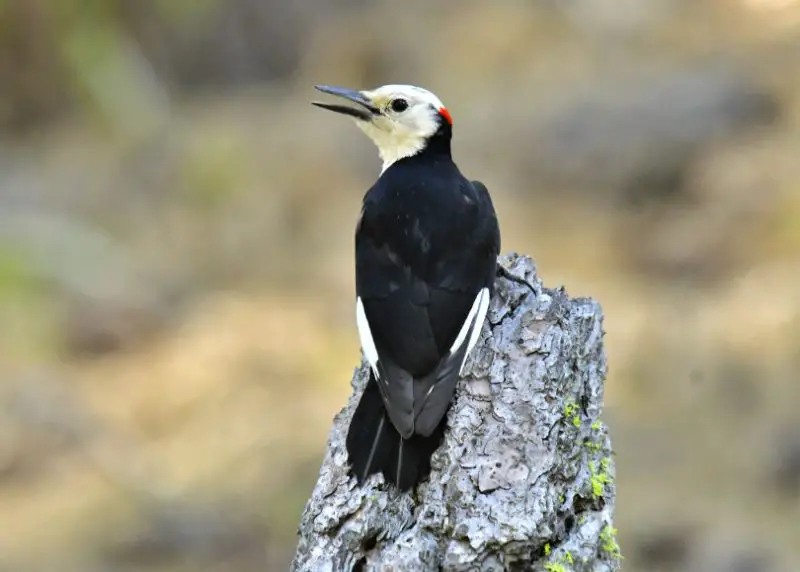
The White-headed Woodpecker is a striking bird characterized by its entirely white head contrasting with its black body and wings. Measuring about 20 to 25 cm in length, it has a strong, chisel-like bill used to drill into pine bark to access insect larvae hidden beneath. This woodpecker is less common than some other species but is easily identifiable due to its distinctive head coloration.
This species spends much of its time foraging on the trunks and branches of mature pine trees, especially ponderosa pines. It feeds mainly on ants, beetle larvae, and other insects, but also consumes seeds and pine nuts. The White-headed Woodpecker’s drumming and tapping on tree trunks serve as communication and territory marking.
In California, White-headed Woodpeckers are found primarily in montane pine forests at mid to high elevations, including parts of the Sierra Nevada and southern Cascades. They prefer open, mature pine woodlands where large trees provide ample feeding and nesting opportunities. Their reliance on old-growth pine habitat makes them sensitive to forest management practices.
Pine Grosbeak (Pinicola enucleator)
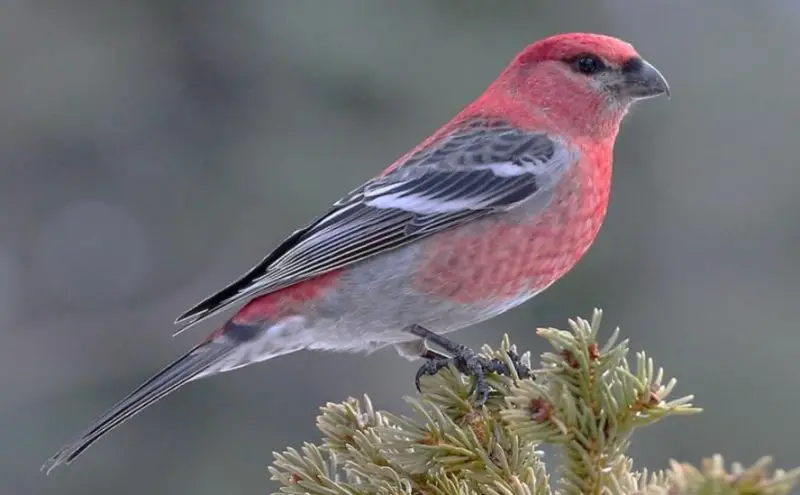
The Pine Grosbeak is a large, plump songbird, roughly 22 to 30 cm long, with males displaying a beautiful reddish plumage, while females tend to be more yellowish or grayish. Its thick bill is well-suited for cracking open seeds and consuming berries, which make up the bulk of its diet. These birds are known for their calm, gentle behavior and often form small flocks in winter.
Primarily found at higher elevations during winter months, Pine Grosbeaks feed on conifer seeds, buds, and a variety of berries. Their diet shifts seasonally, but seeds remain important throughout the year. They are also known to consume insects during breeding season to provide protein for their young.
In California, Pine Grosbeaks are mostly seen in subalpine and boreal forests of the northern Sierra Nevada and the Cascade ranges during winter. They prefer dense coniferous forests with abundant food resources. Their presence is seasonal, as they often migrate to lower elevations or further south during warmer months.
Mountain Bluebird (Sialia currucoides)
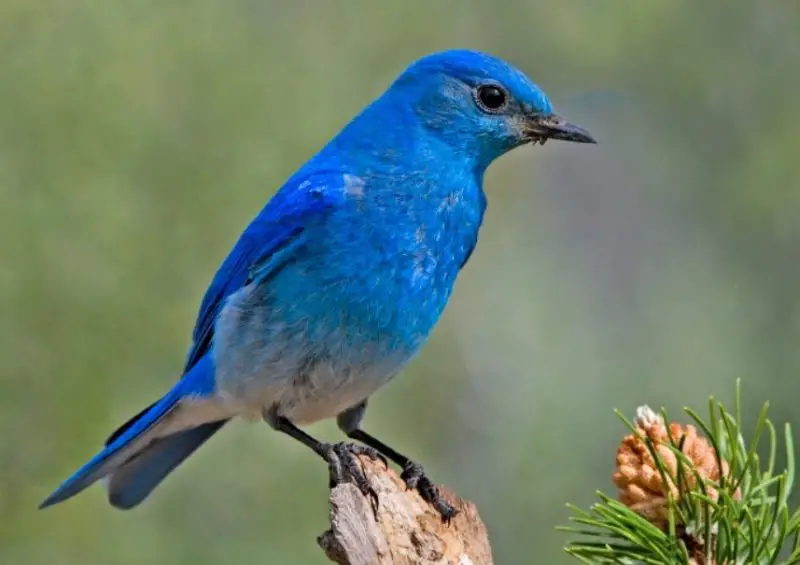
The Mountain Bluebird is a vibrant bird roughly 16 to 21 cm long, with males showcasing brilliant sky-blue plumage that stands out against the often muted tones of mountainous landscapes. Females have a duller gray-blue color, but both sexes are easily recognized by their slender bodies and delicate appearance. This species is known for its melodic, gentle songs.
Mountain Bluebirds prefer open habitats such as meadows, clearings, and shrublands at mid to high elevations. They typically nest in cavities or old woodpecker holes, relying on trees or man-made nest boxes. Their diet mainly consists of insects during the breeding season and berries or seeds in colder months.
In California, Mountain Bluebirds are found throughout mountainous regions like the Sierra Nevada and the eastern Cascades. They are especially common in open areas with scattered trees or shrubs that provide nesting sites and perches. Their striking blue color is a welcome splash of brightness in the mountain environment.
Red Crossbill (Loxia curvirostra)
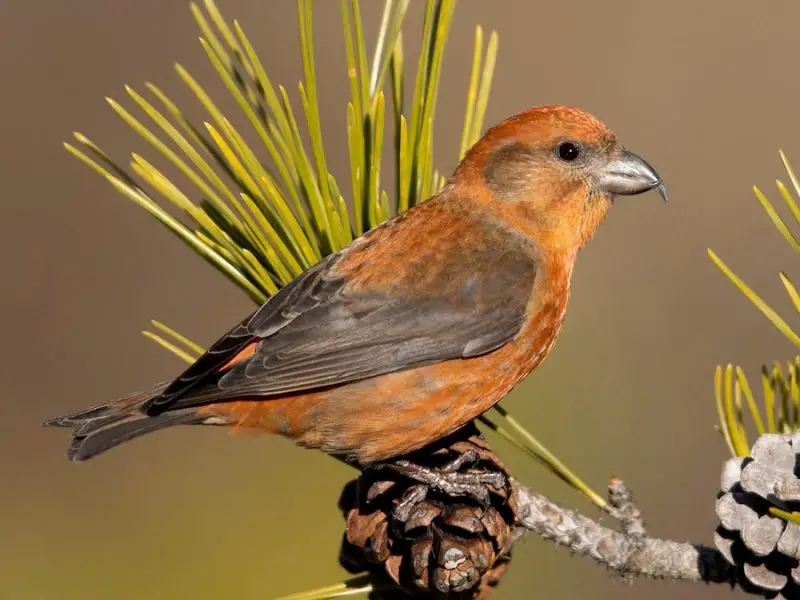
The Red Crossbill is a medium-sized bird, about 16 to 18 cm in length, easily recognized by its unique crossed tips of the upper and lower mandibles. This specialized bill shape allows it to pry open pine cones and extract the seeds inside, which constitute the primary part of its diet. Plumage varies by age and sex, with adult males usually showing reddish tones and females being olive or yellowish.
This bird is highly adapted to coniferous forests and is often seen flying rapidly through pine stands, actively searching for cones. Red Crossbills are nomadic, moving to areas where cone crops are abundant. Their feeding behavior plays an important role in seed dispersal and forest ecology.
In California, Red Crossbills are found mainly in higher elevation pine forests of the Sierra Nevada and Cascade mountains. They inhabit dense coniferous forests but can also be seen near mixed woodlands. Their presence often fluctuates with seed availability, making them somewhat irregular visitors.
Golden Eagle (Aquila chrysaetos)
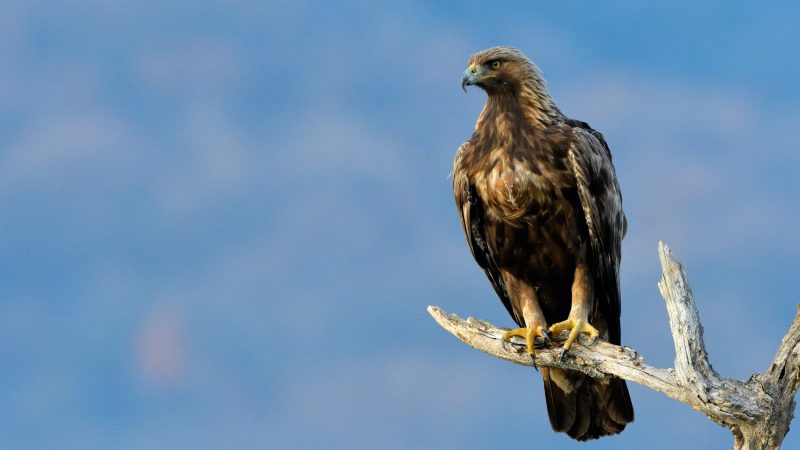
The Golden Eagle is one of California’s largest and most majestic birds of prey, with a wingspan that can exceed two meters and body length around 75 to 90 cm. Its dark brown plumage is complemented by golden feathers on the back of its head and neck. Known for powerful flight and sharp eyesight, it is an apex predator in mountain ecosystems.
This eagle hunts a wide range of prey, including mammals like rabbits, squirrels, and ground squirrels, as well as birds and carrion. It soars high above mountainous terrain, using thermal updrafts to cover large areas while scanning for food. Golden Eagles are territorial and often mate for life, nesting on cliff ledges or large trees.
In California, Golden Eagles are found throughout the state’s mountainous regions, including the Sierra Nevada, Cascades, and coastal ranges. They prefer open habitats near cliffs or large trees for nesting and hunting. Conservation efforts have helped maintain their populations despite historic declines.
Black-backed Woodpecker (Picoides arcticus)
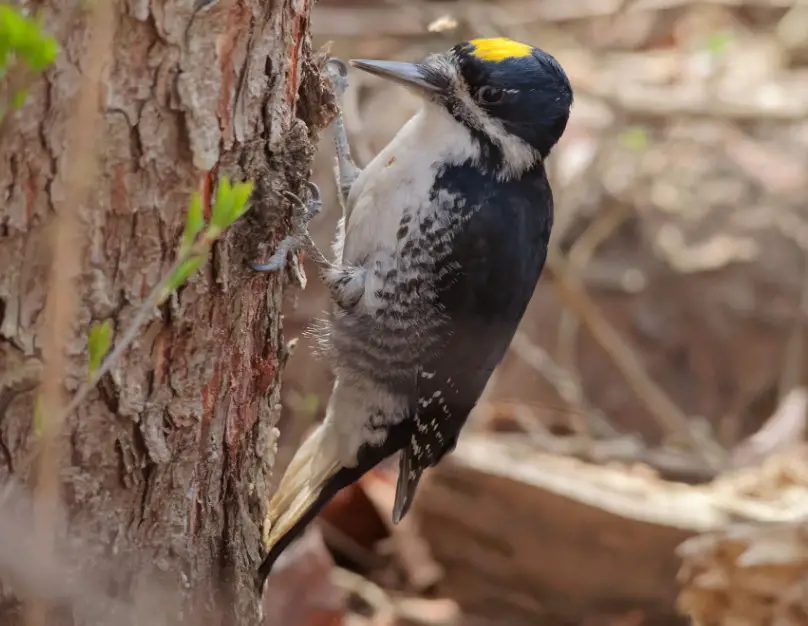
The Black-backed Woodpecker is a rare and striking bird with glossy black plumage on its back and white underparts. Measuring about 22 to 25 cm in length, this woodpecker has a powerful bill adapted for chiseling into burnt trees. It is closely associated with recently burned coniferous forests, where it plays a vital role in the mountain ecosystem by feeding on insects that colonize dead wood.
This species is specialized to exploit post-fire habitats, often found in areas affected by wildfires where other birds are scarce. It drills into charred tree trunks to find wood-boring beetle larvae, which form the bulk of its diet. The Black-backed Woodpecker is also known for its persistent drumming and tapping sounds as it searches for food.
In California, Black-backed Woodpeckers are found mainly in burned pine forests at mid to high elevations, such as parts of the Sierra Nevada and southern Cascades. Their population depends on the availability of recently burned forest patches, making them an important indicator of forest fire health and regeneration.
Mountain Quail (Oreortyx pictus)
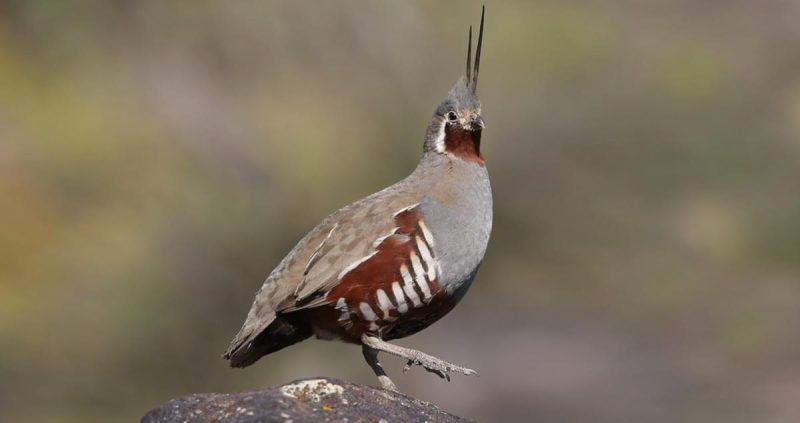
The Mountain Quail is a small, plump ground bird about 25 to 30 cm long, easily recognized by its distinctive plume of feathers that curve forward on its head. Its plumage features intricate patterns of brown, gray, and rust colors, providing excellent camouflage in its preferred habitats. This bird is shy and secretive, often heard before being seen.
Mountain Quails forage on the forest floor of low-elevation mountain slopes and open woodlands, feeding primarily on seeds, leaves, and small insects. They tend to live in coveys and move through dense underbrush for protection. Their calls are soft whistles and chuckles used for communication within groups.
In California, Mountain Quail inhabit foothills and lower mountain forests, including oak woodlands and chaparral areas, particularly in the Sierra Nevada foothills and coastal ranges. They prefer habitats with thick shrub cover that offers shelter and nesting sites. These birds are a symbol of mountainous wilderness and are prized by birdwatchers.
Hermit Thrush (Catharus guttatus)
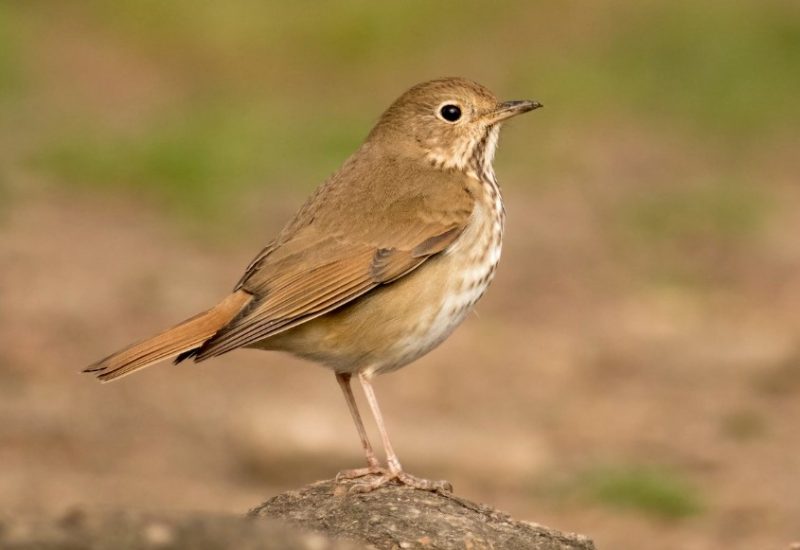
The Hermit Thrush is a medium-sized songbird, roughly 15 to 18 cm long, with warm brown upperparts and pale underparts spotted with dark spots. It has a subtle reddish tail that flicks frequently. This species is well known for its clear, melodious song that echoes through mountain forests during breeding season.
Hermit Thrushes prefer dense coniferous and mixed forests at mid to high elevations. They forage on the ground and in low vegetation for insects, spiders, and berries. Their shy behavior often keeps them hidden, but their beautiful song is a common soundtrack in mountain woodlands.
In California, Hermit Thrushes are widely distributed in mountain ranges such as the Sierra Nevada and Cascades. They inhabit cool, shaded forests with plenty of leaf litter for foraging. Their presence indicates healthy, mature forest ecosystems, and they often migrate to lower elevations or coastal areas in winter.
Red-tailed Hawk (Buteo jamaicensis)
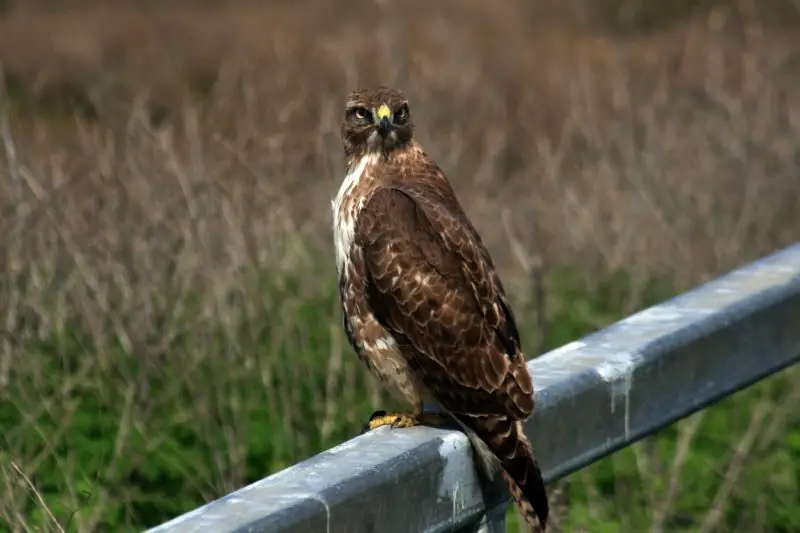
The Red-tailed Hawk is a large raptor, measuring 45 to 65 cm long with a wingspan up to 1.4 meters. It is easily identified by its broad, rounded wings and a distinctive rusty-red tail, visible in flight. This hawk is one of the most common birds of prey in North America and a skilled hunter.
Red-tailed Hawks hunt a variety of prey, including rodents, rabbits, birds, and reptiles. They often perch on high vantage points like trees or cliffs in mountainous and lowland areas to scan for movement below. Their soaring flight and loud, descending scream are familiar sights and sounds in California’s mountains.
In California, Red-tailed Hawks are widespread, found from low foothills to mountain ridges across the state. They adapt to many habitats but prefer open areas mixed with forests for hunting and nesting. Their adaptability makes them a key predator in mountain food webs.
White-tailed Ptarmigan (Lagopus leucura)
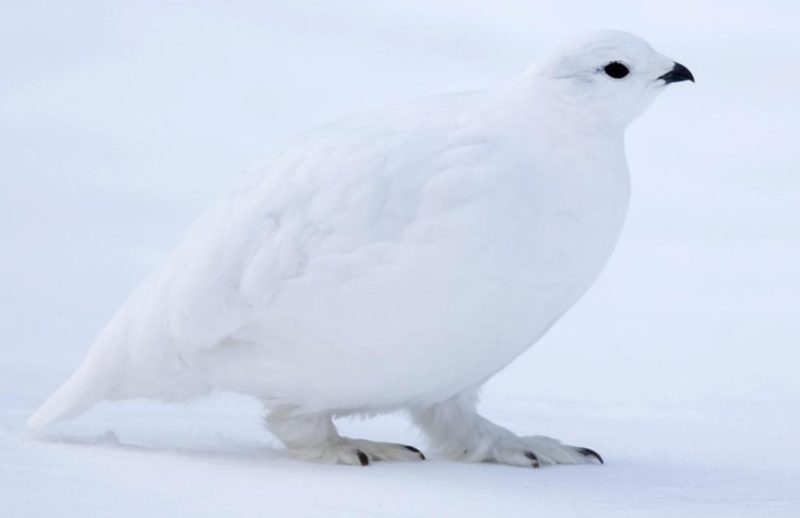
The White-tailed Ptarmigan is a small, stocky bird about 30 cm long, perfectly adapted to cold alpine environments. It changes its plumage color with the seasons—white in winter for camouflage in snow, and mottled brown and gray in summer to blend with rocky terrain. This species has feathered feet that act like snowshoes, enabling it to walk on snow.
This ptarmigan feeds mainly on alpine plants, buds, leaves, and seeds, foraging close to the ground in tundra-like habitats. It is a ground-nesting bird, relying on its cryptic plumage to avoid predators in harsh mountain climates. Its behavior includes walking and short flights over rugged terrain.
In California, White-tailed Ptarmigans are restricted to the highest elevations of the Sierra Nevada mountains, where snow persists for much of the year. They inhabit rocky alpine meadows and talus slopes above the tree line. Their presence is an indicator of pristine alpine ecosystems and climate conditions.
Dark-eyed Junco (Junco hyemalis)
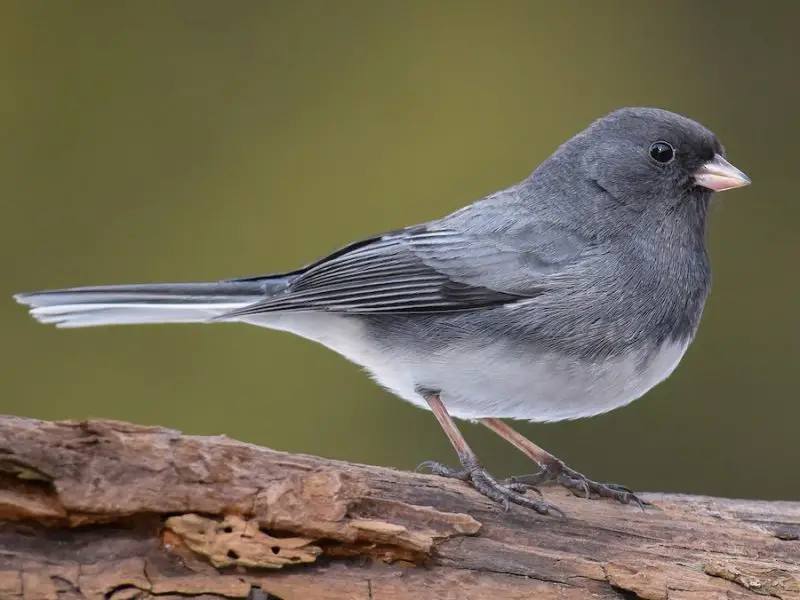
The Dark-eyed Junco is a small, sparrow-sized bird about 15 to 17 cm long, easily recognizable by its slate-gray or brownish coloration and distinctive white outer tail feathers visible in flight. This species is commonly seen in mountain forests, especially during the winter months when many juncos migrate down from higher elevations to lower and more temperate areas.
Dark-eyed Juncos forage primarily on the ground, feeding on seeds, insects, and small invertebrates. They often appear in flocks during colder seasons, hopping actively as they scratch through leaf litter or snow searching for food. Their behavior is social yet cautious, often retreating quickly to cover if disturbed.
In California, Dark-eyed Juncos inhabit coniferous and mixed forests in mountainous regions such as the Sierra Nevada and the Cascades. Their numbers increase noticeably in winter as birds from higher elevations descend. They prefer habitats with ample ground cover and dense shrubs for shelter and nesting during the breeding season.
Yellow-rumped Warbler (Setophaga coronata)
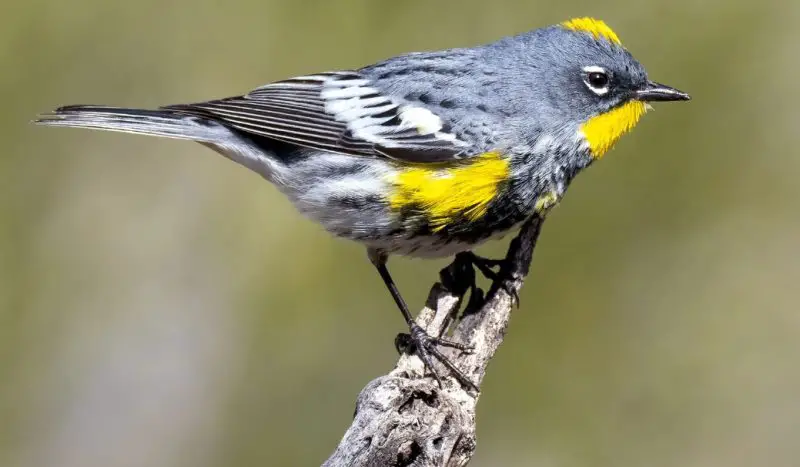
The Yellow-rumped Warbler is a small, energetic songbird about 14 to 15 cm long, notable for the bright yellow patches on its sides, rump, and sometimes crown. These vivid yellow highlights make it one of the easiest warblers to identify, especially in winter plumage when its gray and brown body contrasts with the yellow.
This warbler is a migratory species, often seen in California’s mountain forests during the winter months. It feeds on a varied diet including insects, berries, and seeds. Yellow-rumped Warblers are active foragers, frequently fluttering through trees and shrubs in search of food, and are known for their high-pitched, buzzy song.
In California, Yellow-rumped Warblers are commonly found in montane coniferous forests and mixed woodlands. They prefer areas with abundant berry-producing shrubs and conifers. Their adaptability to different food sources helps them thrive throughout the cooler seasons in mountainous regions.
Northern Flicker (Colaptes auratus)
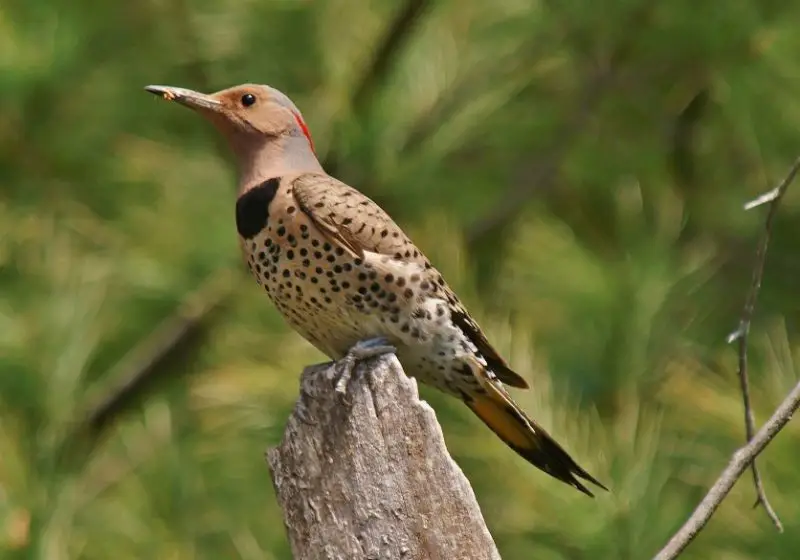
The Northern Flicker is a large woodpecker, measuring around 28 to 34 cm in length, with a brownish-yellow body marked with black spots and bars. It has a distinctive red or black malar stripe on the face depending on the subspecies and a barred back. Unlike many woodpeckers, flickers often forage on the ground searching for ants and beetles.
This species is known for its loud, rhythmic drumming on trees and its loud calls, which are a familiar sound in mountain forests. Northern Flickers use their strong bills to probe into soil and decayed wood for insects. They nest in tree cavities but also excavate their own holes in softer wood.
In California, Northern Flickers inhabit a range of environments from foothills to mountain forests, including oak woodlands and mixed conifer habitats. They are widespread and adaptable, often seen near edges of forests or open areas where foraging is easier. Their presence adds diversity to mountain woodpecker communities.
Spotted Owl (Strix occidentalis)
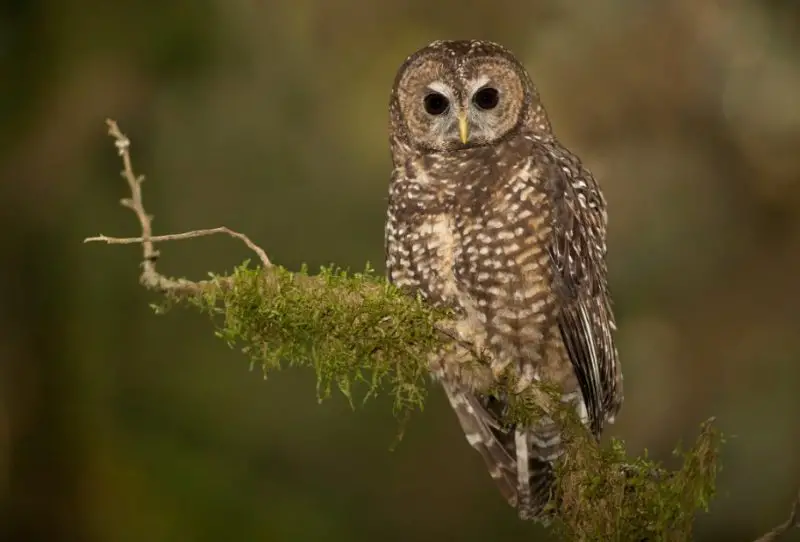
The Spotted Owl is a medium-sized, nocturnal bird of prey measuring approximately 43 to 48 cm in length. It has dark brown plumage with white spots across its body, large dark eyes, and a rounded facial disk. This owl is a specialized inhabitant of mature old-growth forests and dense mountain woodlands.
Spotted Owls hunt primarily at night, feeding on small mammals such as mice, squirrels, and other rodents. They rely on dense canopy cover and complex forest structure for roosting and nesting, often occupying tree cavities or abandoned nests. Their soft hooting calls are iconic sounds of California’s ancient forests.
In California, Spotted Owls are primarily found in old-growth forests of the Sierra Nevada, coastal ranges, and southern Cascades. Their survival depends heavily on the preservation of mature forests with little human disturbance. Conservation efforts focus on protecting their critical habitats from logging and development.
Evening Grosbeak (Coccothraustes vespertinus)
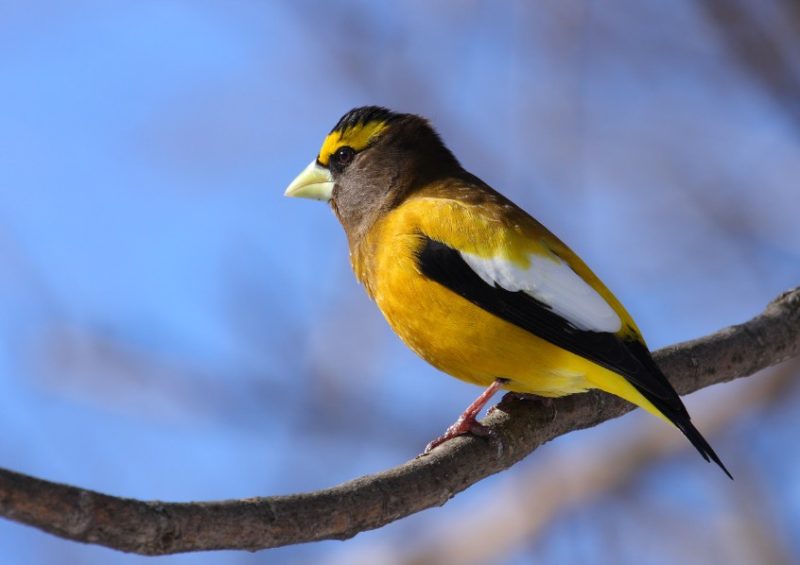
The Evening Grosbeak is a large, robust finch about 18 to 23 cm long, notable for its striking yellow and black plumage. Males display bright yellow bodies with black wings and tail, while females have duller coloration but maintain the bold pattern. This species has a strong, thick bill adapted for cracking open seeds.
These grosbeaks are commonly seen in mountain forests during winter, often forming flocks that forage in conifers for seeds, buds, and berries. They are social birds with loud, musical calls and a distinctive “cheerful” song. Their feeding habits help in seed dispersal across forested landscapes.
In California, Evening Grosbeaks are found primarily in montane coniferous forests during colder months, including the Sierra Nevada and northern Cascades. Their populations can fluctuate widely depending on food availability. Their colorful presence brightens the winter forest scenes and attracts birdwatchers.
FAQ about Mountain Birds of California
What types of birds are commonly found in the mountains of California?
California’s mountain regions host a diverse range of bird species including woodpeckers like the Steller’s Jay and White-headed Woodpecker, raptors such as the Golden Eagle and Northern Goshawk, songbirds like the Mountain Chickadee and Hermit Thrush, and unique species like the American Dipper and White-tailed Ptarmigan. These birds are adapted to various habitats from dense pine forests to alpine meadows.
When is the best time to observe mountain birds in California?
The best time to observe mountain birds in California varies by species, but generally spring through early fall offers ideal conditions when many birds are breeding and more active. Winter months attract some species migrating to lower elevations, such as Dark-eyed Juncos and Pine Grosbeaks, making year-round birdwatching possible with some variation in species seen.
What habitats do mountain birds in California prefer?
Mountain birds in California occupy a variety of habitats depending on their ecological needs. Pine and mixed conifer forests are common homes for species like the Steller’s Jay and Clark’s Nutcracker. Alpine meadows and rocky slopes support birds like the Mountain Bluebird and White-tailed Ptarmigan. Riparian zones and fast-moving streams are favored by species such as the American Dipper.
How do mountain birds in California adapt to seasonal changes?
Many mountain birds adapt by migrating to lower elevations during winter to avoid harsh weather, while others like the White-tailed Ptarmigan change plumage color to blend into snowy environments. Some species cache food like Clark’s Nutcracker, while others alter their diet seasonally, switching between insects, seeds, and berries based on availability.
Are any mountain bird species in California considered endangered or threatened?
Yes, some mountain birds such as the Spotted Owl are considered threatened due to habitat loss and fragmentation. Conservation efforts focus on protecting old-growth forests and managing land use to maintain suitable habitats. Other species may be vulnerable depending on factors like climate change and forest health.
What role do mountain birds play in California’s ecosystems?
Mountain birds contribute significantly to their ecosystems by controlling insect populations, dispersing seeds (like Clark’s Nutcracker with pine seeds), and serving as prey for larger predators. Woodpeckers create nesting cavities used by many other species, while raptors help maintain balanced food webs in mountainous environments.
How can birdwatchers responsibly observe mountain birds in California?
Birdwatchers should maintain a respectful distance to avoid disturbing birds, especially during breeding seasons. Staying on trails, minimizing noise, and avoiding habitat damage are important. Using binoculars or cameras with zoom lenses allows for close observation without interference. Supporting conservation programs helps protect habitats and species for future generations.

